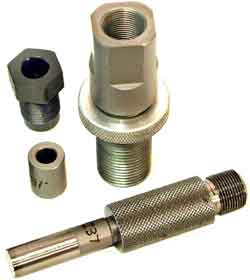|
|
|
Lead Extruder, Small Wire, type -S
|
| |

|
Quantity in Basket:
None
Catalog No.: LED-2-S
Price: $358.00
Shipping Weight: 1.50 pounds
Sorry, we are no longer taking orders for the Lead Extruder, Small Wire, type -S on our legacy website. Please visit our new website at Corbins.com for all future orders. Any question/concerns you can reach us at sales@corbins.com Thank you
|
| |
LED-2-S Lead Extruder Die for the S-Press makes
small diameter wire from .430 wire or .45 caliber lead
bullet (soft lead only).
Since the S-Press has a 2-inch swage stroke, and all Corbin
hand powered presses develop maximum power at the top of
the stroke, the length of the lead "billet" is limited to
about 3/4 inch. Longer bits of lead require too much
effort for extrusion in one stroke (although you can adjust
the die downward a little at a time to use the end of the
stroke).
The LED-2-S is best suited for making .100, .125, .170, and
.185 diameter wire. The larger the diameter, the shorter
the length that can be extruded from a given size of
billet (the starting piece of lead is called a billet in
an extruder). The LED-2-S makes from one to four inches of
wire per stroke, depending on diameter. Fortunately, the
calibers that need these small diameter cores only require
short lengths.
Hydraulic systems develop full power
from the start to finish of the stoke, which is useful for
extruding larger billets. The LED-1-H is used in the Corbin
Hydro Press CHP-1 to make larger and longer wire sizes from
4 inch long lead cylinders of about 3/4-inch diameter.
Instructions:
The 5/8-24 threaded punch screws into the press ram, finger tight. The 7/8-14 threaded die body screws into the press head (top). Adjust the die position so that the die just begins to project from the bottom side of the press head (you can adjust it further when making the first lead extrusion, for best leverage and complete extrusion).
Put the desired diameter of die insert into the top of the die body, and secure it with the threaded retainer. You can tighten the retainer by hand, firmly, or carefully use a smooth jawed box end wrench. Please do not use pliers, pipe wrench, or other serrated tool to grip and tightern the retainer. The end of the extruder die with the chamfer or "funnel" shape is the one which faces the lead billet (faces down).
Either use a soft lead cast .45 pistol bullet without grease in the grooves, or
cast .430 diameter soft lead (Bhn 5) cores of about 3/4-inch length using a Corbin CM-4a core mold. Hard lead will not extrude with safe pressure. Attempting to apply enough pressure to obtain extrusion may destroy the die. When the cores are cool enough to handle, lubricate them with Corbin Swage Lube (CSL-2) by spreading a film of lube on their surface, either by hand (roll between thumb and forefinger with a drop of lube on your fingertip) or by rolling on a stamp pad which has been saturated with lube. If you make them too long, it increases the effort required to extrude, since the longer core engages the press leverage at a lower leverage portion of the stroke. Making them too short does no harm but simply increases the number of times you have to re-load the extruder to get the same total amount of wire length.
Insert a lubricated 3/4-inch long .430 to .450 diameter core, or .45 caliber soft lead pistol bullet, into the bottom of the extruder die. Hold it with one fingeer as needed to slip the extruder punch into the die and take over the support. Raise the ram and see if the die position will let you apply reasonable effort and get extruded wire to come out of the die top. If the effort is too great, raise the position of the die a little at a time until you can extrude wire with firm but not excessive effort. The amount of effort should be about the same as full length resizing a large rifle case (in other words, pressing the handle firmly but not jumping on it).
You cannot make longer wires by adding another billet, and extruding it as part of the previous one. The lead will not stick together. It may extrude a longer wire but the junction probably will be a long, disconnected splice that comes apart when you bend it.
When you have extruded all the wire that will go out the top, there will be a little stem and flange of lead left in the die. Push this out from the top, if you want to make a clean extrusion with another billet. Otherwise there will be a disconnected two-part section of wire that you can't use without it falling apart.
|
Related Item(s)
|
Code
|
Name
|
Price
|
Availability
|
|
|
LED-1-H
|
Lead Wire Extruder, -H
|
$598.00
|
Check at Corbins.com
|
|
LED-1D
|
Lead Wire Extruder Insert, -H
|
$30.00
|
Check at Corbins.com
|
|
LED-2D
|
Lead Wire Extruder Die Insert, type -S
|
$30.00
|
Check at Corbins.com
|
|


































